

Architects Aid in Disaster
Assistance
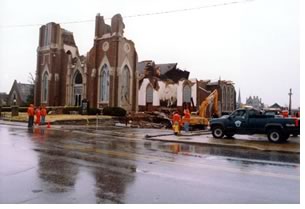 Tumultuous
weather has wreaked havoc nationwide this spring, particularly in the
nation’s heartland. The tornadoes and harsh weather should remind
AIA members of the Institute’s disaster assistance program as it
offers one example of a community ravaged by Mother Nature and built again
by a determined citizenry.
Tumultuous
weather has wreaked havoc nationwide this spring, particularly in the
nation’s heartland. The tornadoes and harsh weather should remind
AIA members of the Institute’s disaster assistance program as it
offers one example of a community ravaged by Mother Nature and built again
by a determined citizenry.
Revival and renewal often offer people hope and a degree of consolation following tragedies. In one recent instance, the people of Clarksville, Tenn., took matters into their own hands and responded to the devastation left in the wake of an F4-strength tornado that ripped through the town in January 1999. The tornado was quick and vicious. It took only a few minutes for the twister to destroy the five-block area that was home to the city’s historic downtown, toppling, for example, the cupola and clock tower on the Montgomery County Courthouse and the twin spires of the gothic Madison Street United Methodist Church, which, along with many other destroyed buildings in the area, had stood since a fire swept through in 1878.
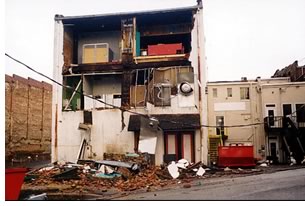 After
the tornado, a team of community and business leaders, public officials,
and concerned citizens set about the task of navigating the rebuilding
process. Charles Harper, FAIA, chair of the AIA Disaster Response Committee,
said that it was not always easy for the community and that it took some
time for the community to hammer out the issues posed by the restorations,
but that now the community is on track and that most of it is rebuilt.
For example, he explained, many in the community objected to the notion
of tearing down the historic county courthouse in favor of building a
new property. To them, the courthouse, which sits at the highest point
in the city, is a symbol of their community with its bell tower visible
as one enters the town. Preservation advocates persevered, and the courthouse
underwent a $10 million restoration project, including a new courts center
and a landscaped green space, which was completed last summer.
After
the tornado, a team of community and business leaders, public officials,
and concerned citizens set about the task of navigating the rebuilding
process. Charles Harper, FAIA, chair of the AIA Disaster Response Committee,
said that it was not always easy for the community and that it took some
time for the community to hammer out the issues posed by the restorations,
but that now the community is on track and that most of it is rebuilt.
For example, he explained, many in the community objected to the notion
of tearing down the historic county courthouse in favor of building a
new property. To them, the courthouse, which sits at the highest point
in the city, is a symbol of their community with its bell tower visible
as one enters the town. Preservation advocates persevered, and the courthouse
underwent a $10 million restoration project, including a new courts center
and a landscaped green space, which was completed last summer.
AIA Middle Tennessee Executive Director Carol Pedigo was involved in two disaster recovery efforts in 15 months—Nashville and Clarksville. She said the first challenge is “finding out who is in charge or who will step up into a leadership role.” In both instances, she worked with her members and the AIA Center on Livable Communities to gather and offer resources. In Clarksville, Pedigo communicated with a city official who had heard about the component’s successes in Nashville and was eager to garner what his city could learn from those experiences.
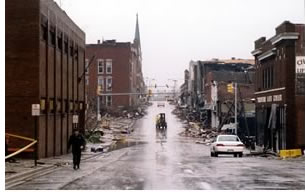 Soon,
a coalition of organizations set up a meeting with the mayor, other city
officials, and all of the businesses that had been hurt in downtown Clarksville.
The group brought in Harper and members of AIA Middle Tennessee who had
been involved in the rebuilding of Nashville. “The process of recovery
is about giving them good information,” Pedigo said. She also noted,
that well-meaning people can “bring leadership and bring a plan,
but unless you have the buy-in of the community of that plan then you’re
not going to have a successful product.”
Soon,
a coalition of organizations set up a meeting with the mayor, other city
officials, and all of the businesses that had been hurt in downtown Clarksville.
The group brought in Harper and members of AIA Middle Tennessee who had
been involved in the rebuilding of Nashville. “The process of recovery
is about giving them good information,” Pedigo said. She also noted,
that well-meaning people can “bring leadership and bring a plan,
but unless you have the buy-in of the community of that plan then you’re
not going to have a successful product.”
Harper, a Kemper Award winner and chair of the Board of Harper Perkins Architects, Wichita Falls, Tex., said the city of Clarksville used the Guidelines for Disaster Response and Recovery, a handbook that outlines initial and long-term disaster responses that AIA members can undertake, particularly at the state and local level. He said he would use that same process in Oklahoma City as he conducts disaster response training there in the wake of twisters that tore through the area last month. “It’s glorious that we have a member like Charles Harper, who will step in when people are at their most vulnerable and not take advantage of them,” Pedigo said.
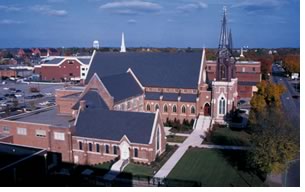 Clarksville
rebuilds
Clarksville
rebuilds
One Clarksville native, Lane Lyle, AIA, president of Lyle Cook Martin
architects, lost both the heart of his beloved community and his architecture
firm to the tornado. As fortunate as people can be in these cases, like
many other design professionals who find themselves in Mother Nature’s
clutches, the architect and his colleagues were well-suited for the tasks
that lay ahead. “It was an intense period of my life,” Lyle
recalled.
First, in the wake of the storm, the Federal Emergency Management Agency cordoned off virtually all the downtown buildings, creating an agonizing situation for professionals who didn’t know if there places of work had a roof over the building or if they were flattened to the ground. Lyle had been able to convince the mayor to give him an escort to his firm because during the years of his practice he had worked on many of the buildings that had been damaged and had documents relating to those projects in his flattened office. But he also recognized there was little information about when others would have the same access. Lyle approached the state fire marshal, a personal acquaintance. Based on the information the official provided, he and fellow architects and structural engineers developed a system for evaluating the buildings’ structural integrity. Then, in about two days, they assessed each of the buildings that FEMA had, as it must do in natural disasters, categorically deemed unsafe. Soon, people were allowed to return to the devastated areas.
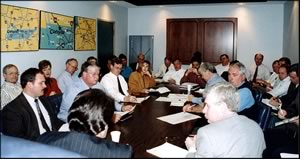 Lyle,
who ultimately rebuilt and returned to his own downtown office, also became
involved in the Central Business Improvement District (CBID), which later
became the Downtown District Partnership (DDP), helping to develop design
guidelines while others in the group worked on streetscape planning and
landscaping and business development. No concrete design guidelines had
existed before, so the city used the opportunity to make needed updates
and infrastructure improvements. As a result, they achieved visible results,
Lyle said.
Lyle,
who ultimately rebuilt and returned to his own downtown office, also became
involved in the Central Business Improvement District (CBID), which later
became the Downtown District Partnership (DDP), helping to develop design
guidelines while others in the group worked on streetscape planning and
landscaping and business development. No concrete design guidelines had
existed before, so the city used the opportunity to make needed updates
and infrastructure improvements. As a result, they achieved visible results,
Lyle said.
The public capital investment dedicated to those efforts ended up to total more than $75 million for 1999-2004, and total private investment more than $95 million, beginning in 1999 and projected through 2015. City officials say land values have more than tripled and investment is expected to continue and grow.
“Sooner or later the government goes away and you look around and you’re on your own,” Lyle said. “Architects are trained as problem solvers and our skills can be used in areas other than planning buildings. Bringing those skills to the table is really important.”
Copyright 2003 The American Institute of Architects.
All rights reserved. Home Page ![]()
![]()
